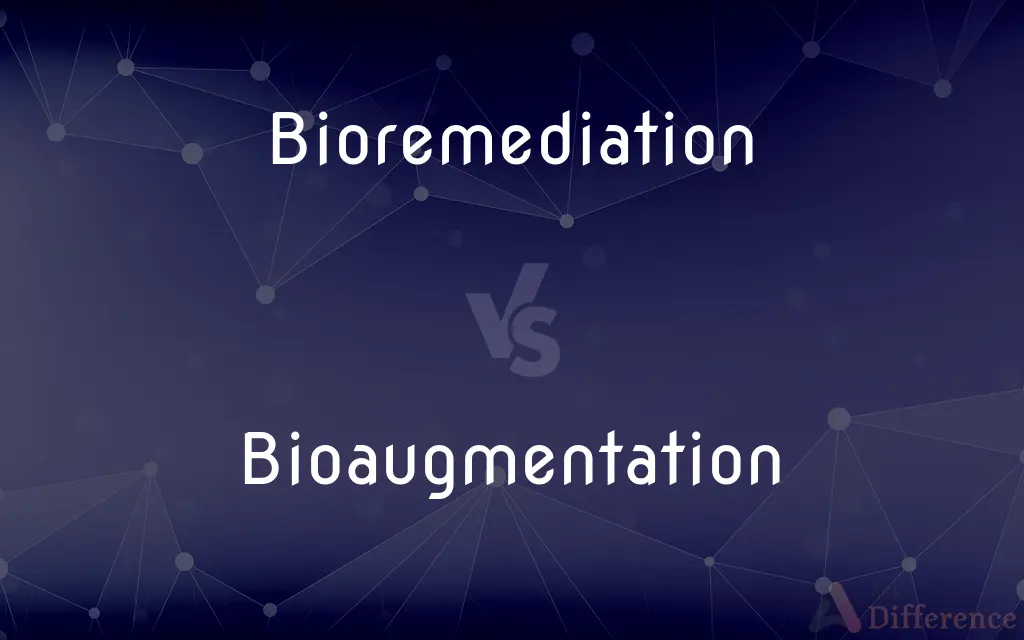Bioremediation vs. Bioaugmentation — What's the Difference?
Edited by Tayyaba Rehman — By Maham Liaqat — Updated on April 4, 2024
Bioremediation uses natural processes to break down pollutants, while bioaugmentation introduces specific microbes to enhance this degradation.

Difference Between Bioremediation and Bioaugmentation
Table of Contents
ADVERTISEMENT
Key Differences
Bioremediation leverages the innate ability of microbes to degrade environmental pollutants into less harmful substances. It’s a natural process that relies on the existing microbial population and environmental conditions to remediate contaminated sites. On the other hand, bioaugmentation is a more targeted approach where specific strains of microbes, known for their pollutant-degrading capabilities, are introduced into the environment to accelerate the biodegradation process.
Bioremediation can be a slower process, as it is dependent on the suitability of environmental conditions and the presence of indigenous microbial communities capable of degrading the pollutants. Bioaugmentation, by introducing specially selected or engineered microbes, aims to overcome these limitations, offering a faster and often more predictable outcome.
One of the key advantages of bioremediation is its minimal impact on the natural environment, promoting the restoration of ecosystems through natural processes. Conversely, bioaugmentation, while highly effective, requires careful consideration of the ecological impact of introducing non-native microbes, including the potential for unintended consequences on local biodiversity.
Bioremediation techniques are often less costly and more sustainable in the long term, as they enhance the natural degradation processes. Bioaugmentation may involve additional costs related to the cultivation and introduction of specific microbial strains but can be more efficient for degrading particularly resistant pollutants.
Both bioremediation and bioaugmentation play crucial roles in environmental cleanup efforts. Bioremediation is widely applicable for a range of pollutants and environments, making it a versatile tool for ecological restoration. Bioaugmentation, with its ability to target specific contaminants, is invaluable in scenarios where natural bioremediation processes are insufficient.
ADVERTISEMENT
Comparison Chart
Definition
Natural process using microbes to degrade pollutants
Introducing specific microbes to enhance degradation
Speed of Process
Generally slower, depends on site conditions
Faster, due to use of specialized microbes
Environmental Impact
Minimal, enhances natural recovery
Potential risks to biodiversity
Cost
Often lower, utilizes natural processes
Higher due to microbial cultivation and introduction
Application Flexibility
Broad, depends on existing microbial activity
Specific, tailored to target certain pollutants
Compare with Definitions
Bioremediation
A process utilizing living organisms to break down pollutants in the environment.
The wetlands act as natural bioremediation systems, filtering pollutants from water.
Bioaugmentation
Often involves genetically engineered organisms.
Genetically modified bacteria in bioaugmentation processes target specific heavy metals.
Bioremediation
Involves enhancing natural biodegradation processes.
Adding nutrients can stimulate bioremediation in oil-contaminated soils.
Bioaugmentation
Enhances the speed and efficiency of bioremediation.
By adding specialized microbes, bioaugmentation significantly reduced the cleanup time.
Bioremediation
Can be applied in situ or ex situ.
In situ bioremediation treats contaminants directly at the site.
Bioaugmentation
The addition of cultured microbes to degrade pollutants more effectively.
Bioaugmentation was used to break down the toxic compounds in industrial wastewater.
Bioremediation
An eco-friendly remediation technique.
Bioremediation offers a sustainable alternative to chemical cleanup methods.
Bioaugmentation
Specifically tailored for challenging pollutants.
Bioaugmentation targets pollutants that are resistant to natural biodegradation processes.
Bioremediation
Utilizes microbial metabolism to degrade organic pollutants.
Certain bacteria in bioremediation processes can degrade petroleum hydrocarbons.
Bioaugmentation
Requires careful monitoring to prevent ecological imbalance.
Continuous assessment is necessary when bioaugmentation introduces non-native species.
Bioremediation
Bioremediation is a process used to treat contaminated media, including water, soil and subsurface material, by altering environmental conditions to stimulate growth of microorganisms and degrade the target pollutants. Cases where bioremediation is commonly seen is oil spills, soils contaminated with acidic mining drainage, underground pipe leaks, and crime scene cleanups.
Bioaugmentation
Biological augmentation is the addition of archaea or bacterial cultures required to speed up the rate of degradation of a contaminant. Organisms that originate from contaminated areas may already be able to break down waste, but perhaps inefficiently and slowly.
Bioremediation
The use of biological agents, such as bacteria or plants, to remove or neutralize contaminants, as in polluted soil or water.
Bioaugmentation
The use of microorganisms to help decompose pollutants
Bioremediation
(biochemistry) The use of biological organisms, usually microorganisms, to remove contaminants, especially from polluted water
Bioremediation
The branch of biotechnology that uses biological processes to overcome environmental problems.
Bioremediation
The branch of biotechnology that uses biological process to overcome environmental problems
Bioremediation
The act of treating waste or pollutants by the use of microorganisms (as bacteria) that can break down the undesirable substances
Common Curiosities
What is bioremediation?
Bioremediation is a natural process that uses microorganisms to break down environmental pollutants into less harmful substances.
How does bioaugmentation work?
Bioaugmentation works by introducing specific strains of microorganisms into a contaminated environment to accelerate the degradation of pollutants.
How long does bioremediation take to clean up a polluted site?
The timeframe varies widely depending on the extent of contamination, pollutant type, and environmental conditions, ranging from months to several years.
Can bioaugmentation be used for all types of environmental contamination?
Bioaugmentation is most effective for specific types of contamination and may not be suitable for all pollutants or environmental conditions.
How do environmental conditions affect bioremediation?
Temperature, pH, moisture, and nutrient availability can significantly impact the effectiveness of bioremediation processes.
What are the benefits of using bioremediation for oil spills?
Bioremediation for oil spills offers an environmentally friendly alternative that can effectively break down oil into harmless substances over time.
Can bioaugmentation affect groundwater quality?
If not properly managed, bioaugmentation can potentially impact groundwater quality, necessitating careful monitoring and control measures.
Can bioremediation occur naturally?
Yes, bioremediation can occur naturally as part of an ecosystem's inherent ability to clean up pollutants using indigenous microbes.
What types of pollutants can be treated with bioaugmentation?
Bioaugmentation is particularly effective for pollutants that are resistant to natural degradation processes, including certain chemicals and heavy metals.
Is bioremediation always preferable to physical or chemical cleanup methods?
While bioremediation is often more sustainable and eco-friendly, its suitability depends on the type of pollutant, the extent of contamination, and the site conditions.
Are there any legal or regulatory considerations for using bioaugmentation?
Yes, the introduction of specific microbes, especially genetically modified ones, into the environment is subject to regulatory approval and oversight.
Can bioremediation and bioaugmentation be used together?
Yes, these methods can be complementary, with bioaugmentation enhancing the effectiveness of natural bioremediation processes in certain cases.
Is bioaugmentation a cost-effective method for environmental cleanup?
While initially more expensive due to the need for microbial cultivation and introduction, bioaugmentation can be cost-effective for tackling specific, challenging pollutants.
What are the risks associated with bioaugmentation?
The primary risks involve the potential impact on local biodiversity and ecological balance due to the introduction of non-native or genetically modified organisms.
How do you choose between bioremediation and bioaugmentation?
The choice depends on the contamination type, the presence of native microbial populations capable of degradation, environmental conditions, and cost considerations.
Share Your Discovery

Previous Comparison
Insight vs. Judgement
Next Comparison
Fat vs. PhatAuthor Spotlight
Written by
Maham LiaqatEdited by
Tayyaba RehmanTayyaba Rehman is a distinguished writer, currently serving as a primary contributor to askdifference.com. As a researcher in semantics and etymology, Tayyaba's passion for the complexity of languages and their distinctions has found a perfect home on the platform. Tayyaba delves into the intricacies of language, distinguishing between commonly confused words and phrases, thereby providing clarity for readers worldwide.














































